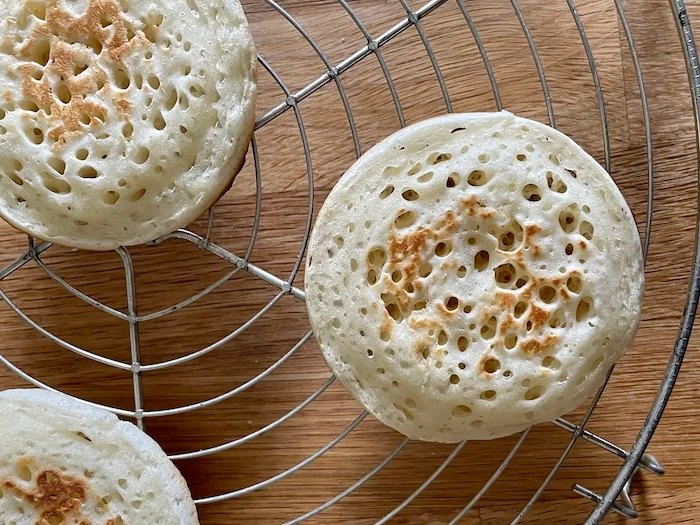Sharing this recipe for no yeast crumpets I developed and am quite proud of.

I don’t know why this doesn’t exist already (or maybe it does but is just obscure). The no-yeast crumpet recipes I have found previously don’t really have holes on top and looked more like pancakes than crumpets imo. All the recipes for holey crumpets I found on the internet were either made from sourdough discard or some combination of yeast and baking powder/baking soda.
I’ve tried a sourdough discard + baking soda crumpet recipe (the KA one I believe) and also two different crumpet recipes which use instant yeast and baking powder. None worked for me, they all turned out cakey, mushy, and/or gross. I decided to develop my own crumpet recipe. My first attempt using sourdough to leaven the batter was not ideal.
After several failures, I went and bought crumpets from the supermarket out of sheer frustration and noticed that there was no yeast listed in the ingredients. I consider this brand of crumpets (Oakrun bakery) to have the ideal texture as it has a very defined honeycomb with a bouncy texture when toasted. (Aside from no yeast, they also had more sugar than the crumpet recipes I found online.) So I decided to use this as a guideline to develop my no-yeast crumpet recipe. I don’t have access to some of the leaveners they use, so I only use baking soda. After some tinkering with hydration, I think I’ve hit a pretty good ratio.
Recipe is here. Hope you give this recipe a try and get consistent holey crumpets as well.
The most important thing about cooking crumpets is having a flat and heavy griddle or pan that retains heat well. Also, you should modify the vinegar amount if your white vinegar is not 5% acetic acid.
Process video here: (not sure why video embed not working?)
https://www.instagram.com/p/C9U7379yGd1/
or watch on my instagram or tiktok.
I am fairly certain that the addition of potassium bicarbonate will give a better honeycomb texture. Although I have not tried this yet, you can get “lye water” at Chinese grocery stores which is essentially a solution of sodium bicarbonate and potassium carbonate. I think this will work fairly well to give crumpets a good honeycomb texture. Chinese lye water is traditionally used in bai tang gao/bok tong go, a honeycomb textured rice cake that is fermented with yeast (leading to sourness) which then reacts with this sodium bicarbonate and potassium carbonate mixture when steamed to give high, defined honeycombs. Personally, I think the texture of a good bok tong go is very similar to that of a good crumpet.
Would be curious to know if anyone has experience baking with potassium bicarbonate or this potassium carbonate and sodium bicarbonate solution.